Yige Yuan
From Outcomes to Processes: Guiding PRM Learning from ORM for Inference-Time Alignment
Jun 14, 2025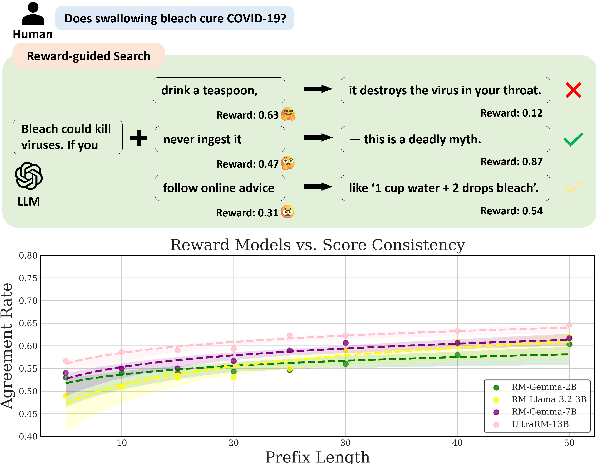
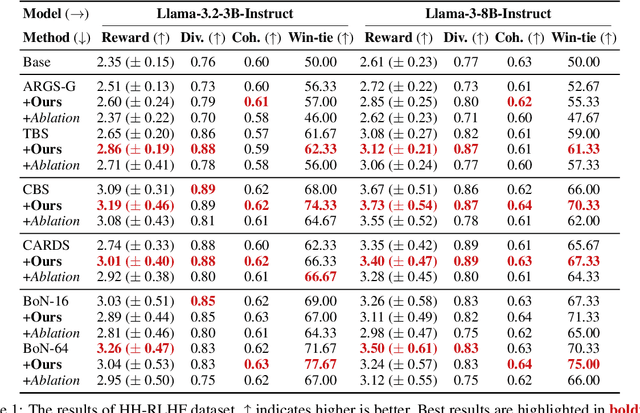


Abstract:Inference-time alignment methods have gained significant attention for their efficiency and effectiveness in aligning large language models (LLMs) with human preferences. However, existing dominant approaches using reward-guided search (RGS) primarily rely on outcome reward models (ORMs), which suffer from a critical granularity mismatch: ORMs are designed to provide outcome rewards for complete responses, while RGS methods rely on process rewards to guide the policy, leading to inconsistent scoring and suboptimal alignment. To address this challenge, we introduce process reward models (PRMs) into RGS and argue that an ideal PRM should satisfy two objectives: Score Consistency, ensuring coherent evaluation across partial and complete responses, and Preference Consistency, aligning partial sequence assessments with human preferences. Based on these, we propose SP-PRM, a novel dual-consistency framework integrating score consistency-based and preference consistency-based partial evaluation modules without relying on human annotation. Extensive experiments on dialogue, summarization, and reasoning tasks demonstrate that SP-PRM substantially enhances existing RGS methods, achieving a 3.6%-10.3% improvement in GPT-4 evaluation scores across all tasks.
Incentivizing Strong Reasoning from Weak Supervision
May 28, 2025Abstract:Large language models (LLMs) have demonstrated impressive performance on reasoning-intensive tasks, but enhancing their reasoning abilities typically relies on either reinforcement learning (RL) with verifiable signals or supervised fine-tuning (SFT) with high-quality long chain-of-thought (CoT) demonstrations, both of which are expensive. In this paper, we study a novel problem of incentivizing the reasoning capacity of LLMs without expensive high-quality demonstrations and reinforcement learning. We investigate whether the reasoning capabilities of LLMs can be effectively incentivized via supervision from significantly weaker models. We further analyze when and why such weak supervision succeeds in eliciting reasoning abilities in stronger models. Our findings show that supervision from significantly weaker reasoners can substantially improve student reasoning performance, recovering close to 94% of the gains of expensive RL at a fraction of the cost. Experiments across diverse benchmarks and model architectures demonstrate that weak reasoners can effectively incentivize reasoning in stronger student models, consistently improving performance across a wide range of reasoning tasks. Our results suggest that this simple weak-to-strong paradigm is a promising and generalizable alternative to costly methods for incentivizing strong reasoning capabilities at inference-time in LLMs. The code is publicly available at https://github.com/yuanyige/w2sr.
Inference-time Alignment in Continuous Space
May 26, 2025Abstract:Aligning large language models with human feedback at inference time has received increasing attention due to its flexibility. Existing methods rely on generating multiple responses from the base policy for search using a reward model, which can be considered as searching in a discrete response space. However, these methods struggle to explore informative candidates when the base policy is weak or the candidate set is small, resulting in limited effectiveness. In this paper, to address this problem, we propose Simple Energy Adaptation ($\textbf{SEA}$), a simple yet effective algorithm for inference-time alignment. In contrast to expensive search over the discrete space, SEA directly adapts original responses from the base policy toward the optimal one via gradient-based sampling in continuous latent space. Specifically, SEA formulates inference as an iterative optimization procedure on an energy function over actions in the continuous space defined by the optimal policy, enabling simple and effective alignment. For instance, despite its simplicity, SEA outperforms the second-best baseline with a relative improvement of up to $ \textbf{77.51%}$ on AdvBench and $\textbf{16.36%}$ on MATH. Our code is publicly available at https://github.com/yuanyige/SEA
Incentivizing Reasoning from Weak Supervision
May 26, 2025Abstract:Large language models (LLMs) have demonstrated impressive performance on reasoning-intensive tasks, but enhancing their reasoning abilities typically relies on either reinforcement learning (RL) with verifiable signals or supervised fine-tuning (SFT) with high-quality long chain-of-thought (CoT) demonstrations, both of which are expensive. In this paper, we study a novel problem of incentivizing the reasoning capacity of LLMs without expensive high-quality demonstrations and reinforcement learning. We investigate whether the reasoning capabilities of LLMs can be effectively incentivized via supervision from significantly weaker models. We further analyze when and why such weak supervision succeeds in eliciting reasoning abilities in stronger models. Our findings show that supervision from significantly weaker reasoners can substantially improve student reasoning performance, recovering close to 94% of the gains of expensive RL at a fraction of the cost. Experiments across diverse benchmarks and model architectures demonstrate that weak reasoners can effectively incentivize reasoning in stronger student models, consistently improving performance across a wide range of reasoning tasks. Our results suggest that this simple weak-to-strong paradigm is a promising and generalizable alternative to costly methods for incentivizing strong reasoning capabilities at inference-time in LLMs. The code is publicly available at https://github.com/yuanyige/W2SR.
InfoNCE is a Free Lunch for Semantically guided Graph Contrastive Learning
May 07, 2025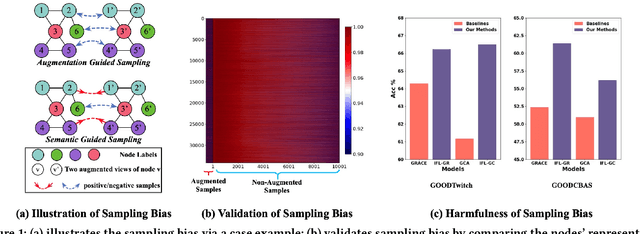
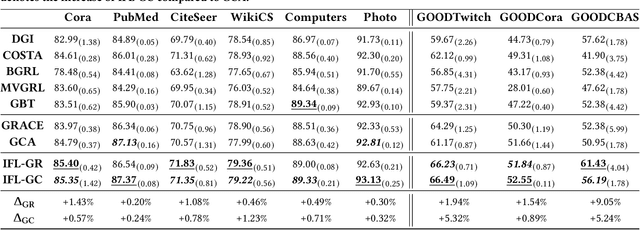
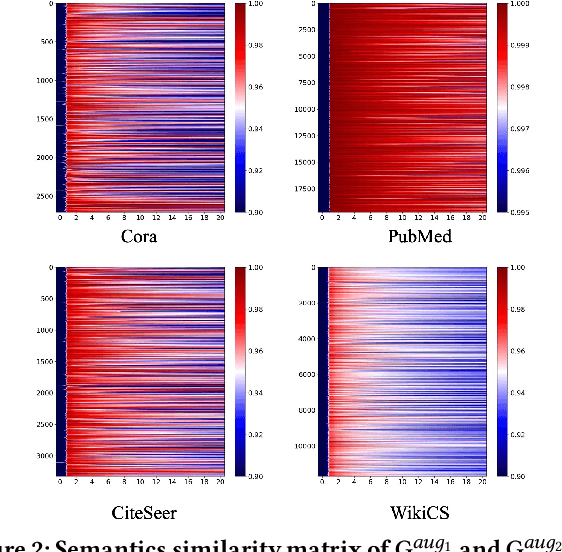

Abstract:As an important graph pre-training method, Graph Contrastive Learning (GCL) continues to play a crucial role in the ongoing surge of research on graph foundation models or LLM as enhancer for graphs. Traditional GCL optimizes InfoNCE by using augmentations to define self-supervised tasks, treating augmented pairs as positive samples and others as negative. However, this leads to semantically similar pairs being classified as negative, causing significant sampling bias and limiting performance. In this paper, we argue that GCL is essentially a Positive-Unlabeled (PU) learning problem, where the definition of self-supervised tasks should be semantically guided, i.e., augmented samples with similar semantics are considered positive, while others, with unknown semantics, are treated as unlabeled. From this perspective, the key lies in how to extract semantic information. To achieve this, we propose IFL-GCL, using InfoNCE as a "free lunch" to extract semantic information. Specifically, We first prove that under InfoNCE, the representation similarity of node pairs aligns with the probability that the corresponding contrastive sample is positive. Then we redefine the maximum likelihood objective based on the corrected samples, leading to a new InfoNCE loss function. Extensive experiments on both the graph pretraining framework and LLM as an enhancer show significantly improvements of IFL-GCL in both IID and OOD scenarios, achieving up to a 9.05% improvement, validating the effectiveness of semantically guided. Code for IFL-GCL is publicly available at: https://github.com/Camel-Prince/IFL-GCL.
On a Connection Between Imitation Learning and RLHF
Mar 07, 2025Abstract:This work studies the alignment of large language models with preference data from an imitation learning perspective. We establish a close theoretical connection between reinforcement learning from human feedback RLHF and imitation learning (IL), revealing that RLHF implicitly performs imitation learning on the preference data distribution. Building on this connection, we propose DIL, a principled framework that directly optimizes the imitation learning objective. DIL provides a unified imitation learning perspective on alignment, encompassing existing alignment algorithms as special cases while naturally introducing new variants. By bridging IL and RLHF, DIL offers new insights into alignment with RLHF. Extensive experiments demonstrate that DIL outperforms existing methods on various challenging benchmarks.
MIGE: A Unified Framework for Multimodal Instruction-Based Image Generation and Editing
Feb 28, 2025Abstract:Despite significant progress in diffusion-based image generation, subject-driven generation and instruction-based editing remain challenging. Existing methods typically treat them separately, struggling with limited high-quality data and poor generalization. However, both tasks require capturing complex visual variations while maintaining consistency between inputs and outputs. Therefore, we propose MIGE, a unified framework that standardizes task representations using multimodal instructions. It treats subject-driven generation as creation on a blank canvas and instruction-based editing as modification of an existing image, establishing a shared input-output formulation. MIGE introduces a novel multimodal encoder that maps free-form multimodal instructions into a unified vision-language space, integrating visual and semantic features through a feature fusion mechanism.This unification enables joint training of both tasks, providing two key advantages: (1) Cross-Task Enhancement: By leveraging shared visual and semantic representations, joint training improves instruction adherence and visual consistency in both subject-driven generation and instruction-based editing. (2) Generalization: Learning in a unified format facilitates cross-task knowledge transfer, enabling MIGE to generalize to novel compositional tasks, including instruction-based subject-driven editing. Experiments show that MIGE excels in both subject-driven generation and instruction-based editing while setting a state-of-the-art in the new task of instruction-based subject-driven editing. Code and model have been publicly available at https://github.com/Eureka-Maggie/MIGE.
SimPER: A Minimalist Approach to Preference Alignment without Hyperparameters
Feb 04, 2025



Abstract:Existing preference optimization objectives for language model alignment require additional hyperparameters that must be extensively tuned to achieve optimal performance, increasing both the complexity and time required for fine-tuning large language models. In this paper, we propose a simple yet effective hyperparameter-free preference optimization algorithm for alignment. We observe that promising performance can be achieved simply by optimizing inverse perplexity, which is calculated as the inverse of the exponentiated average log-likelihood of the chosen and rejected responses in the preference dataset. The resulting simple learning objective, SimPER, is easy to implement and eliminates the need for expensive hyperparameter tuning and a reference model, making it both computationally and memory efficient. Extensive experiments on widely used real-world benchmarks, including MT-Bench, AlpacaEval 2, and 10 key benchmarks of the Open LLM Leaderboard with 5 base models, demonstrate that SimPER consistently and significantly outperforms existing approaches-even without any hyperparameters or a reference model . For example, despite its simplicity, SimPER outperforms state-of-the-art methods by up to 5.7 points on AlpacaEval 2 and achieves the highest average ranking across 10 benchmarks on the Open LLM Leaderboard. The source code for SimPER is publicly available at: https://github.com/tengxiao1/SimPER.
Cal-DPO: Calibrated Direct Preference Optimization for Language Model Alignment
Dec 19, 2024Abstract:We study the problem of aligning large language models (LLMs) with human preference data. Contrastive preference optimization has shown promising results in aligning LLMs with available preference data by optimizing the implicit reward associated with the policy. However, the contrastive objective focuses mainly on the relative values of implicit rewards associated with two responses while ignoring their actual values, resulting in suboptimal alignment with human preferences. To address this limitation, we propose calibrated direct preference optimization (Cal-DPO), a simple yet effective algorithm. We show that substantial improvement in alignment with the given preferences can be achieved simply by calibrating the implicit reward to ensure that the learned implicit rewards are comparable in scale to the ground-truth rewards. We demonstrate the theoretical advantages of Cal-DPO over existing approaches. The results of our experiments on a variety of standard benchmarks show that Cal-DPO remarkably improves off-the-shelf methods.
Fact-Level Confidence Calibration and Self-Correction
Nov 20, 2024



Abstract:Confidence calibration in LLMs, i.e., aligning their self-assessed confidence with the actual accuracy of their responses, enabling them to self-evaluate the correctness of their outputs. However, current calibration methods for LLMs typically estimate two scalars to represent overall response confidence and correctness, which is inadequate for long-form generation where the response includes multiple atomic facts and may be partially confident and correct. These methods also overlook the relevance of each fact to the query. To address these challenges, we propose a Fact-Level Calibration framework that operates at a finer granularity, calibrating confidence to relevance-weighted correctness at the fact level. Furthermore, comprehensive analysis under the framework inspired the development of Confidence-Guided Fact-level Self-Correction ($\textbf{ConFix}$), which uses high-confidence facts within a response as additional knowledge to improve low-confidence ones. Extensive experiments across four datasets and six models demonstrate that ConFix effectively mitigates hallucinations without requiring external knowledge sources such as retrieval systems.
 Add to Chrome
Add to Chrome Add to Firefox
Add to Firefox Add to Edge
Add to Edge